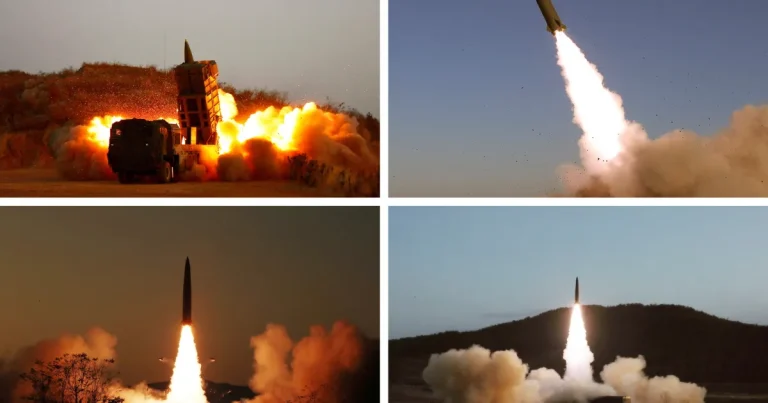North Korea Fires Ballistic Missiles Ahead of Asia-Pacific Summit in South Korea
SEOUL, Oct 22 – In a move likely to raise tensions across East Asia, North Korea fired multiple short-range ballistic missiles on Wednesday, just one week ahead of a major Asia-Pacific summit that will bring together regional and global leaders in South Korea.
According to South Korea’s Joint Chiefs of Staff, the missiles were launched from an inland area of North Korea and flew eastward before landing in waters off the Korean Peninsula. While full details are still emerging, initial military assessments indicated that several short-range missiles traveled approximately 350 kilometers.
This launch marks North Korea’s first ballistic missile test since May and comes amid rising geopolitical uncertainty in the region. It is widely viewed by analysts as a deliberate show of force timed to precede the Asia-Pacific Economic Cooperation (APEC) summit, set to convene next week in the South Korean capital, Seoul.
Timing Sparks Global Concern
The timing of the missile launch is being interpreted by many observers as a calculated act by Pyongyang to draw attention to its strategic capabilities just as global and regional powers prepare to discuss economic cooperation and security challenges in the region.
Among the key figures expected at the APEC summit are U.S. President Donald Trump, South Korean President Lee Jae Myung, and Chinese President Xi Jinping. The presence of these leaders—each representing countries with vested interests in Korean Peninsula stability—has further heightened scrutiny of North Korea’s motives.
While Pyongyang has yet to release a formal statement regarding the missile test, its recent history of timed provocations has led defense experts to believe the move was a direct signal to both South Korea and the United States.
Japan’s Calm but Watchful Response
Japan, which has often reacted strongly to North Korean missile launches—especially when missiles fly over or near its territory—adopted a relatively measured stance in response to Wednesday’s tests.
Prime Minister Sanae Takaichi stated that there was no immediate threat to Japan’s national security, noting that the projectiles did not enter Japanese airspace or exclusive economic zones. She confirmed that Tokyo remains in close coordination with the United States and South Korea and is sharing real-time tracking and threat assessments with allies.
Still, Japanese defense officials remain on high alert, with maritime and air defense forces monitoring potential follow-up launches.
First Test Since May Highlights Pyongyang’s Strategy
Wednesday’s test is North Korea’s first known launch of ballistic missiles since May 8, when it fired a series of short-range projectiles from its east coast. Since then, the country has kept a relatively low military profile, though U.S. and South Korean intelligence agencies have tracked activity at several missile-related facilities throughout the summer.
The reemergence of missile testing, especially ahead of the APEC summit, reaffirms North Korea’s commitment to maintaining and advancing its weapons capabilities in the face of mounting international pressure and sanctions.
In early October, North Korea showcased its latest intercontinental ballistic missile (ICBM) at a military parade in Pyongyang. The event, attended by high-ranking Chinese officials, featured several new weapons systems and emphasized the country’s growing deterrent capability.
A Decade of Defiance
North Korea’s ballistic missile program has made significant advances over the past decade, evolving from short-range tests in the early 2010s to now possessing ICBMs theoretically capable of reaching the U.S. mainland.
This development has occurred despite the imposition of multiple rounds of United Nations Security Council sanctions aimed at halting North Korea’s nuclear and missile development programs. These sanctions, supported by the United States, South Korea, Japan, and even China to varying degrees, have failed to stop Pyongyang’s steady march toward more advanced weaponry.
What makes these launches especially provocative is that ballistic missile testing is explicitly banned under U.N. resolutions. Each test not only flouts international law but also threatens the fragile balance of power in East Asia.
Diplomatic Fallout Ahead of the Summit
With the APEC summit looming, the missile launches add a new layer of complexity to an already sensitive diplomatic environment.
For South Korea, the provocation is particularly personal. As host of this year’s APEC summit, the administration of President Lee Jae Myung hoped the forum would highlight Seoul’s growing regional leadership and promote peaceful cooperation. Instead, the attention may now shift toward security concerns and managing the North Korean threat.
President Donald Trump, known for his volatile relationship with North Korea during his previous term, is expected to respond sternly. His earlier approach to Pyongyang swung between threats of military action and personal diplomacy with North Korean leader Kim Jong-un. It remains unclear what strategy he will pursue this time, but observers anticipate a firm statement condemning the launches.
Meanwhile, Chinese President Xi Jinping finds himself in a delicate position. China is North Korea’s largest trading partner and its most important diplomatic ally, yet Beijing has expressed increasing frustration with Pyongyang’s provocative behavior. At the same time, China opposes increased U.S. military presence near its borders and may seek to use the summit to argue for restraint on all sides.
Strategic Implications
Beyond the immediate political ramifications, North Korea’s latest missile tests carry deeper strategic implications for the region and beyond.
1. Demonstrating Capability and Resolve
By firing multiple missiles in quick succession, North Korea is reaffirming that it possesses a wide range of short- and medium-range missile systems. These weapons, though not capable of striking the U.S. mainland, can target South Korean and Japanese military installations, posing a credible regional threat.
2. Leverage Ahead of Talks
North Korea has historically used missile tests to gain leverage in negotiations. Whether it is seeking relief from sanctions, international recognition as a nuclear state, or security guarantees, missile tests remind the world of what’s at stake if Pyongyang’s concerns are ignored.
3. Testing the Allies’ Coordination
These launches test the coordination and resolve of the U.S.-South Korea-Japan trilateral security alliance. The speed and cohesion of their response can serve as a deterrent—or conversely, a signal of weakness—depending on how effectively they act in unison.
4. Internal Signaling
Internally, missile launches serve a propaganda function. They boost national pride, showcase military strength, and allow the regime to project confidence at a time of economic difficulty and diplomatic isolation.
5. Sanctions and Enforcement Questions
The test also raises fresh questions about the efficacy of international sanctions. Despite years of restrictions, North Korea continues to produce and test missiles, suggesting that current enforcement measures may be insufficient.
Military Reactions and Preparedness
Following the launch, South Korea’s military raised its alert level and is closely monitoring North Korea for signs of additional provocations. Joint military drills between South Korea and the United States are also expected to be stepped up in the coming days, both as a response and a deterrent.
The U.S. Indo-Pacific Command issued a brief statement confirming the launches and reaffirming America’s commitment to the defense of its allies. “While we assess these events do not pose an immediate threat to U.S. personnel or territory, or to our allies, the missile launches highlight the destabilizing impact of North Korea’s unlawful weapons programs,” the statement read.
Japan also placed its Self-Defense Forces on increased readiness but did not mobilize additional assets.
The Path Forward: Will Diplomacy Prevail?
The Asia-Pacific summit represents a rare opportunity for direct dialogue among leaders of major global powers. Yet North Korea’s actions threaten to overshadow economic discussions with renewed security concerns.
Some diplomats and analysts remain hopeful that the summit could pave the way for a resumption of dialogue between North Korea and the international community. Others are more skeptical, warning that Pyongyang may escalate further if it perceives no benefit from restraint.
Ultimately, the way forward will depend on a combination of deterrence, diplomacy, and unity among North Korea’s neighbors and adversaries. If regional powers can present a coherent strategy, there may yet be space to prevent a further slide into confrontation.
Conclusion
North Korea’s latest ballistic missile test underscores its determination to remain at the forefront of international attention, regardless of sanctions or diplomatic isolation. The timing—just days before a high-stakes summit—suggests Pyongyang is willing to use military provocation as a tool for strategic messaging.
As leaders prepare to meet in Seoul, the missile launches serve as a stark reminder of the ongoing security challenges facing the region. Whether the APEC summit can offer a pathway back to stability—or become another casualty of great-power rivalry—remains to be seen.
One thing is clear: the world will be watching.

